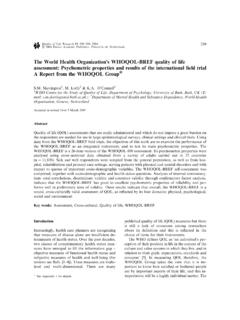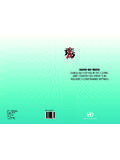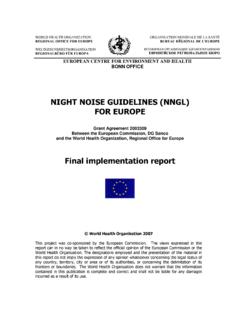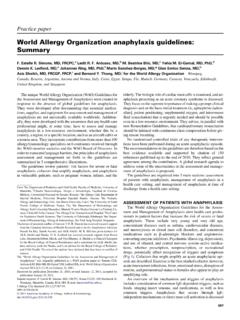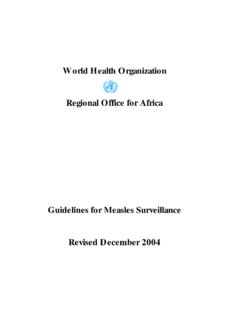Transcription of The World Health Organization three-step …
1 EditorialThe World Health Organization three - step analgesic laddercomesofageEighteen years ago, the W orld Health Organization (WHO) published a document entitled Cancer PainR elief, which set out the principles of cancer painmanagement based on the use of a three - step analgesicladder .1 The document was derived from consensusguidelines produced some four years 1996,the WHO published an updated version of Cancer PainR elief, which again was based on the use of a three -stepanalgesic ladder , and also the principles by mouth , bythe clock , by the ladder , for the individual and attention to detail .3 The updated version of the three - step ladder is shown in Figure years is a long time in medicine. Admittedly,the WHO guidelines have been updated during thisperiod, but the second edition is essentially the same asthe first edition. Most commentators agree that theoriginal guidelines were appropriate for their time, butsome suggest that the current guidelines are less relevantin the new millennium.
2 So, are the WHO guidelines stillvalid?The WHO guidelines arose from evidence of poormanagement of cancer pain in both developing anddeveloped countries. One of the reasons, if not the mainreason, for this situation was the reluctance of individualhealth professionals, institutions and governments to use strong opioids because of misplaced fears of addictionand tolerance amongst patients, and of illegal useamongst the wider community. Thus, one of the mainaims of the WHO guidelines was to legitimize, and soincrease, the prescribing of strong opioids amongstpatients with moderate to severe cancer pain. WHOdata suggest that the publication of the guidelines hasbeen associated with an increase in the usage of opioids inmany parts of the of the major criticisms of the three - step ladder hasbeen the lack of strong evidence of its effectiveness.
3 In1995, Jadad and Browman conducted a systematic reviewof the studies evaluating the WHO thestudies included in the review, 69 /100% of patientsachieved adequate analgesia . However, the authorscomment that for methodological reasons the evidencethey (the studies) provide is insufficient to estimateconfidently the effectiveness of the WHO analgesicladder . Their criticisms were that the studies were small,had limited follow-up periods or high dropout rates, andlacked comparator groups. Because of this they conclude, it would be difficult to know whether the WHO ladderhas really improved the management of cancer pain .Jadad and Browman s criticisms were subsequentlyaddressed and dismissed by some of the developers of theWHO ,6In essence, these authors argued thatthe guidelines were not suggesting a new treatment, butpromoting better use of existing drugs, opioids formoderate to severe pain, and that the validation studieswere setting out to prove that these drugs could be usedeffectively and safely for cancer-related pain, could beused at any stage of the disease, and could be continuedfor prolonged major criticism of the three - step ladder hasbeen that it is nonspecific.
4 Thus, physicians reviewing thesame patient could prescribe different treatment regi-mens, despite using the same treatment template. Aclassic example of this phenomenon is the managementof patients with neuropathic pain, where some physiciansuse drugs for neuropathic pain ( antidepressants andanticonvulsants)3at step one, whilst other physiciansonly use these drugs at step three . However, we wouldsuggest that this lack of specificity is actually a positivefeature, since it promotes the concept of individualisedpatient recently, a criticism of the three - step ladder hasbeen that it overlooks the benefits of other methods ofpain relief, such as disease-modifying therapies, non-pharmacological therapies, and interventional , the WHO guidelines do endorse the use ofthese other treatment modalities, although they do notappear on the illustration of the three - step ladder.
5 CancerPain Relief contains much more information than just thethree- step ladder, and so it is important that Health careprofessionals refer to the WHO guidelines in theirentirety, rather than basing practice on an isolatedillustration of the three - step ladder. Ultimately, the useof these other treatment modalities, and also of opioidsfor moderate to severe pain, depends on their availability,which is likely to vary from country to i at ive Medi ci n e2004;18:175 /176# the WHO guidelines have undoubtedly had amajor (positive) impact on the management of cancerpain, the evidence base for the three - step ladder remainsrelatively weak. This lack of evidence needs to beaddressed. It would not now be feasible to conduct arandomized controlled trial of the three - step ladder, butit would be possible to conduct randomized controlledtrials of alternative models such as a two- step ladder ( from step one to step three ), and also of whether drugs for neuropathic pain should be commenced atstep one, two or three .
6 The results of such studies wouldimprove the evidence for the use of the three - step ladder,and might lead to the development of variations of theladder based on the aetiology of the pain, or thea vailability of certain conclusion, we suggest that the WHO guidelinesremain valid, and are likely to remain the cornerstone ofcancer pain management for the foreseeable , there is no evidence that alternative regimensare better than the WHO guidelines. However, the WHOguidelines will need to continue to develop, and be tested,in order to maintain their Colette ReidResearch FellowandDrAndrewDaviesMcAlpine Macmillan Consultant Senior LecturerUniversity of BristolDepartment of Palliative MedicineBristol Haematology and Oncology CentreBristol, BS2 8ED, UKReferences1 W orld Health pain relief. Geneva:WHO, Stjernsward J , Colleau SM, Ventafridda V . The W orldHealth Organization Cancer Pain and Palliative CareProgram.
7 Past, present, and Pain SymptomManage1996;12: 65 W orld Health Pain Relief. 2nd : WHO, Jadad AR, Browman GP . The WHO analgesic ladder forcancer pain management. Stepping up the quality of ;274: 1870 T wycross R, Lickiss N. Pain control and the W orld HealthOrganization Analgesic ;275: Ventafridda V , Stjernsward J . Pain control and the W orldHealth Organization Analgesic ;275:835 Ahmedzai SH. Window of opportunity for pain control inthe terminally ;357: 1304 World Health Organization three - step analge-sic ladder (1996).176 Editorial
